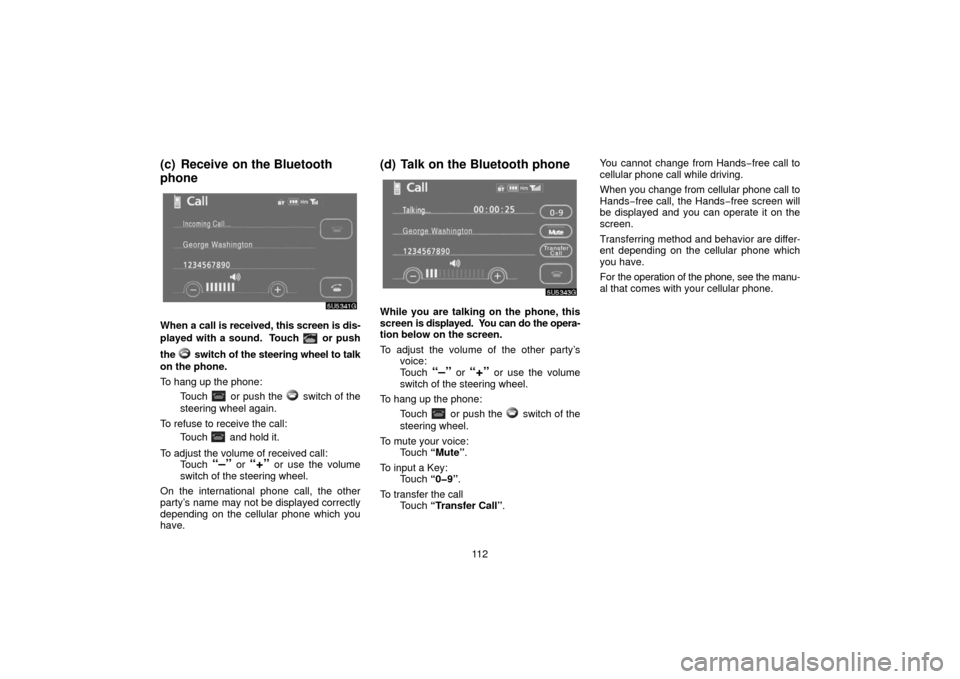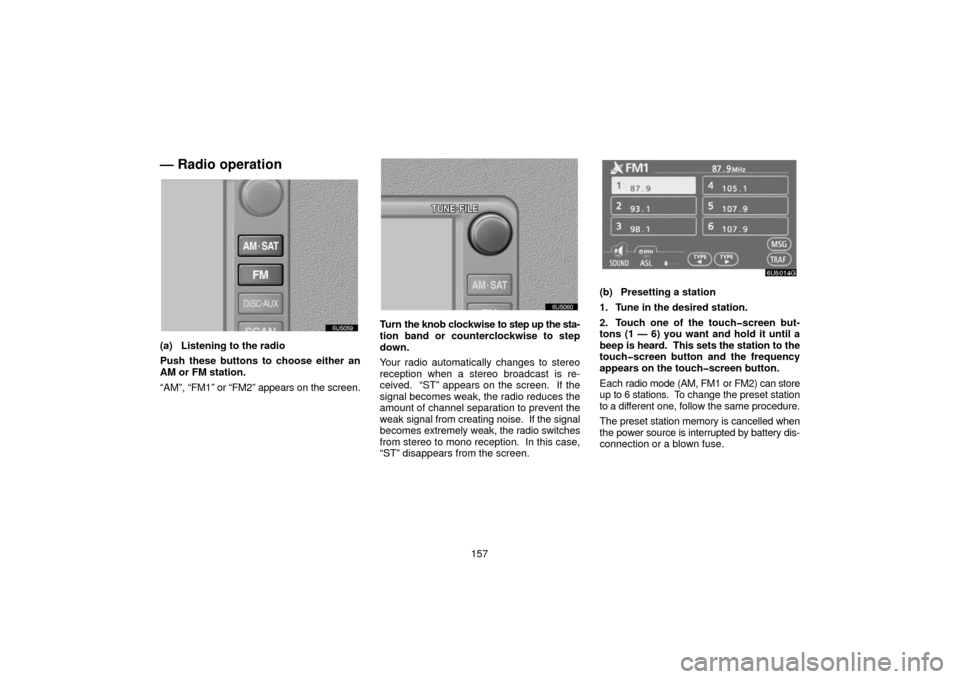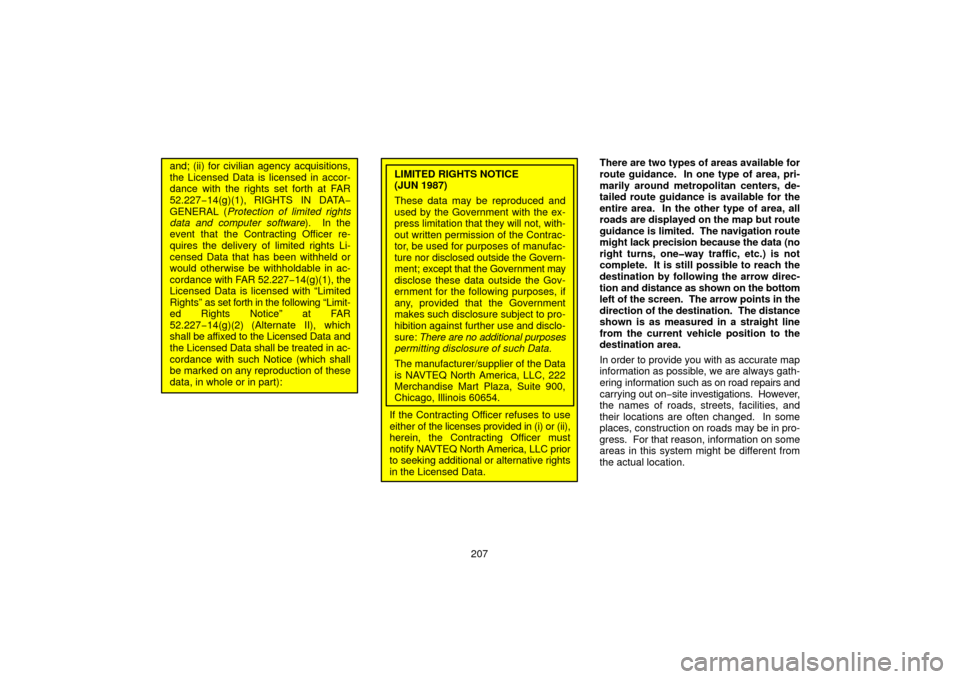fuse TOYOTA 4RUNNER 2006 N210 / 4.G Navigation Manual
[x] Cancel search | Manufacturer: TOYOTA, Model Year: 2006, Model line: 4RUNNER, Model: TOYOTA 4RUNNER 2006 N210 / 4.GPages: 220, PDF Size: 6.29 MB
Page 122 of 220

11 2
(c) Receive on the Bluetooth
phone
When a call is received, this screen is dis-
played with a sound. Touch
or push
the
switch of the steering wheel to talk
on the phone.
To hang up the phone:
Touch
or push the switch of the
steering wheel again.
To refuse to receive the call: Touch
and hold it.
To adjust the volume of received call: Touch
“–” or “+” or use the volume
switch of the steering wheel.
On the international phone call, the other
party’s name may not be displayed correctly
depending on the cellular phone which you
have.
(d) Talk on the Bluetooth phone
While you are talking on the phone, this
screen is displayed. You can do the opera-
tion below on the screen.
To adjust the volume of the other party’s voice:
Touch
“–” or “+” or use the volume
switch of the steering wheel.
To hang up the phone: Touch
or push the switch of the
steering wheel.
To mute your voice: Touch “Mute”.
To input a Key: Touch “0�9”.
To transfer the call Touch “Transfer Call” . You cannot change from Hands
−free call to
cellular phone call while driving.
When you change from cellular phone call to
Hands −free call, the Hands −free screen will
be displayed and you can operate it on the
screen.
Transferring method and behavior are differ-
ent depending on the cellular phone which
you have.
For the operation of the phone, see the manu-
al that comes with your cellular phone.
Page 167 of 220

157
— Radio operation
(a) Listening to the radio
Push these buttons to choose either an
AM or FM station.
“AM”, “FM1” or “FM2” appears on the screen.
Turn the knob clockwise to step up the sta-
tion band or counterclockwise to step
down.
Your radio automatically changes to stereo
reception when a stereo broadcast is re-
ceived. “ST” appears on the screen. If the
signal becomes weak, the radio reduces the
amount of channel separation to prevent the
weak signal from creating noise. If the signal
becomes extremely weak, the radio switches
from stereo to mono reception. In this case,
“ST” disappears from the screen.
(b) Presetting a station
1. Tune in the desired station.
2. Touch one of the touch�screen but-
tons (1 — 6) you want and hold it until a
beep is heard. This sets the station to the
touch�screen button and the frequency
appears on the touch�screen button.
Each radio mode (AM, FM1 or FM2) can store
up to 6 stations. To change the preset station
to a different one, follow the same procedure.
The preset station memory is cancelled when
the power source is interrupted by battery dis-
connection or a blown fuse.
Page 217 of 220

207
and; (ii) for civilian agency acquisitions,
the Licensed Data is licensed in accor-
dance with the rights set forth at FAR
52.227−14(g)(1), RIGHTS IN DATA−
GENERAL (Protection of limited rights
data and computer software). In the
event that the Contracting Officer re-
quires the delivery of limited rights Li-
censed Data that has been withheld or
would otherwise be withholdable in ac-
cordance with FAR 52.227 −14(g)(1), the
Licensed Data is licensed with “Limited
Rights” as set forth in the following “Limit-
ed Rights Notice” at FAR
52.227 −14(g)(2) (Alternate II), which
shall be af fixed to the Licensed Data and
the Licensed Data shall be treated in ac-
cordance with such Notice (which shall
be marked on any reproduction of these
data, in whole or in part):LIMITED RIGHTS NOTICE
(JUN 1987)
These data may be reproduced and
used by the Government with the ex-
press limitation that they will not, with-
out written permission of the Contrac-
tor, be used for purposes of manufac-
ture nor disclosed outside the Govern-
ment; except that the Government may
disclose these data outside the Gov-
ernment for the following purposes, if
any, provided that the Government
makes such disclosure subject to pro-
hibition against further use and disclo-
sure: There are no additional purposes
permitting disclosure of such Data.
The manufacturer/supplier of the Data
is NAVTEQ North America, LLC, 222
Merchandise Mart Plaza, Suite 900,
Chicago, Illinois 60654.
If the Contracting Officer refuses to use
either of the licenses provided in (i) or (ii),
herein, the Contracting Officer must
notify NA VTEQ North America, LLC prior
to seeking additional or alternative rights
in the Licensed Data. There are two types of areas available for
route guidance. In one type of area, pri-
marily around metropolitan centers, de-
tailed route guidance is available for the
entire area. In the other type of area, all
roads are displayed on the map but route
guidance is
limited. The navigation route
might lack precision because the data (no
right turns, one�way traffic, etc.) is not
complete. It is still possible to reach the
destination by following the arrow direc-
tion and distance as shown on the bottom
left of the screen. The arrow points in the
direction of the destination. The distance
shown is as measured in a straight line
from the current vehicle position to the
destination area.
In order to provide you with as accurate map
information as possible, we are always gath-
ering information such as on road repairs and
carrying out on−site investigations. However,
the names of roads, streets, facilities, and
their locations are often changed. In some
places, construction on roads may be in pro-
gress. For that reason, information on some
areas in this system might be different from
the actual location.